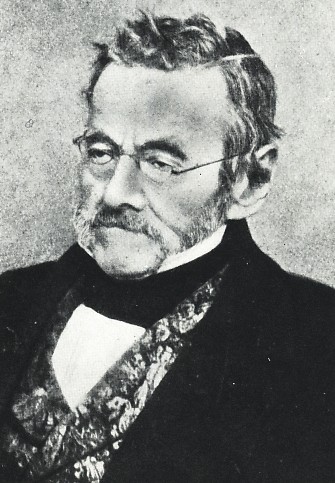<Back to Index>
- Jurist John Austin, 1790
- Writer Karl Anton Postl (Charles Sealsfield), 1793
- Queen Consort of Hanover Frederica of Mecklenburg - Strelitz, 1778
PAGE SPONSOR

Charles Sealsfield was the pseudonym of Austrian - American journalist Carl (or Karl) Anton Postl (3 March 1793 - 26 May 1864), an advocate for a German democracy and author of Romantic novels with American backgrounds and travelogues.
He was born at Popice u Znojma (Poppitz) near Znojmo in Moravia. His schooling completed, he entered the Knights of the Cross with the Red Star in Prague, where he became a priest. In the autumn of 1822, apparently fleeing the repressive government of Metternich, he fled to the United States, where he assumed the name of Charles Sealsfield. In 1826 he returned to Germany and published a book on America (Die Vereinigten Staaten von Nordamerika). Next he published an outspoken criticism of Austria, published first in German, then adapted in English (Austria as it is, or, sketches of continental courts, by an eye - witness, 1828) which was published anonymously in London; this book offended the Austrian authorities, making him a wanted man in that country, but its author's identity remained unknown. Meanwhile he had returned to America, where he published his first novel, also in English, Tokeah, or the White Rose (1828; translated in German by Gustav Höcker). He now turned journalist, first in New York City and subsequently in Paris and London, writing accounts of American life as a correspondent for various journals. In 1832 he settled in Switzerland, and in 1860 purchased a small estate near Solothurn. Here he died in May 1864. His will first revealed the fact that he was the former monk, Postl.
It is as a German language novelist that he is best known. His Tokeah appeared in German under the title Der Legitime und die Republikaner (1838), and was followed by Der Virey und die Aristokraten oder Mexiko im Jahre 1812 (1835), Lebensbilder aus beiden Hemisphären (1835 - 1837), Sturm-, Land- und Seebilder (1838), Das Kajütenbuch, oder Nationale Charakteristiken (1842). Sealsfield occupies an important position in the development of the German historical novel at a period when Walter Scott's influence was beginning to wane. He endeavoured to widen the scope of historical fiction, to describe great national and political movements, without forfeiting the sympathy of his readers for the individual characters of the story.
In 1844, Theodor Mundt declared Sealsfield (whose name he had misread as "Seatsfield") the greatest American author. The Boston Daily Advertiser and other newspapers commenced a search for the true identity of "Seatsfield," but many believed the whole story to be a hoax. The Knickerbocker ran an elaborate satire on the affair in its June 1844 issue.
Sealsfield's Gesammelte Werke appeared in 18 vols. (1843 - 1846). A new edition of his complete works in German and English (Sämtliche Werke), chiefly in photographic facsimile, though with new introductions and editorial apparatus) was edited by Sealsfield scholar Karl J.R. Arndt and published by Olms beginning in 1972.